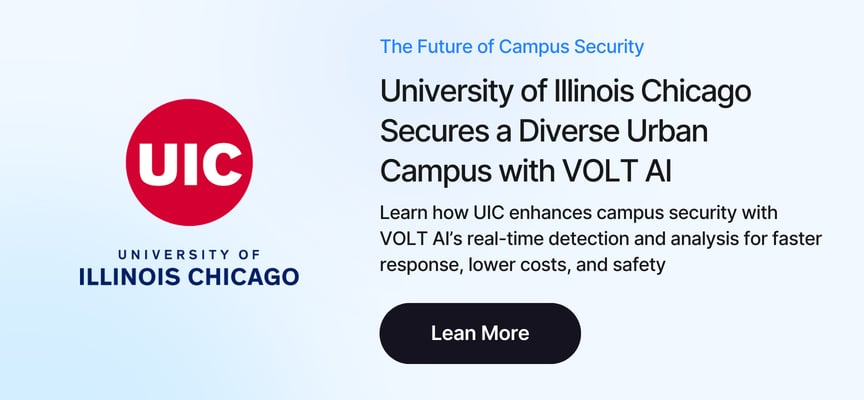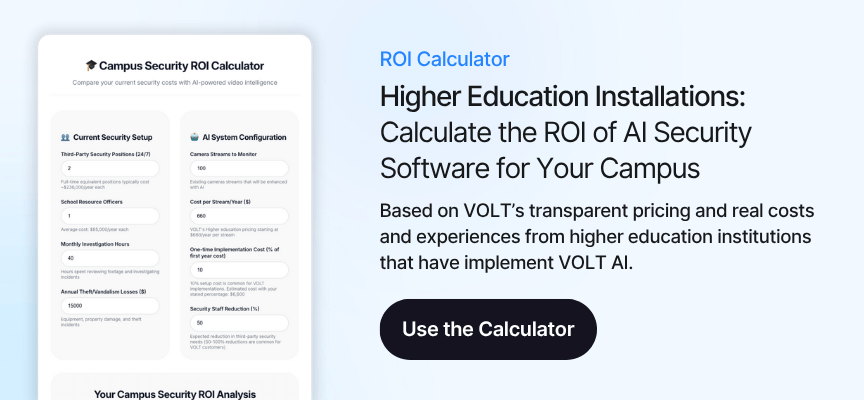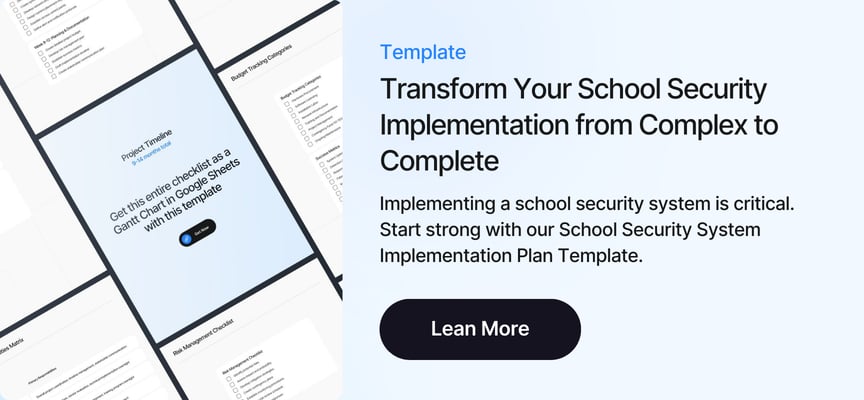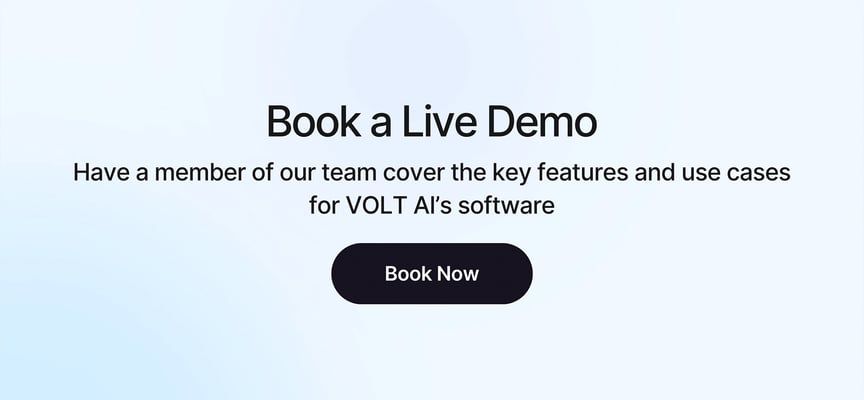Key Points
Campus security teams face unprecedented staffing challenges, but AI technology provides powerful solutions that transform limited resources into comprehensive protection systems:
- Coverage Expansion: AI enables 24/7 monitoring of hundreds of camera feeds with minimal staff, eliminating coverage gaps that plague traditional campus security operations
- Resource Optimization: Universities report reducing third-party security costs by up to 50% while improving incident response times from minutes to seconds
- Proactive Response: Real-time threat detection and tracking allows campus security teams to prevent incidents rather than simply investigate after the fact
- Enhanced Situational Awareness: Automated alerts with precise location data and visual tracking eliminate guesswork in emergency response
- Operational Efficiency: AI handles routine monitoring tasks, freeing security personnel for high-value activities like community engagement and threat assessment
The Campus Security Resource Challenge
Campus security teams nationwide face an impossible equation that affects universities of all sizes. These institutions need comprehensive protection across vast facilities and diverse student populations, but budget constraints limit staffing to skeleton crews that struggle to provide adequate coverage.
Most higher education institutions operate with security teams stretched thin across multiple shifts, leaving critical coverage gaps during off-hours and emergencies. The traditional approach requires human operators to monitor dozens or hundreds of camera feeds simultaneously, creating vulnerabilities that determined threats can exploit.
Research shows that human attention to surveillance footage drops dramatically after just 12 minutes, with 95% of activities missed after 22 minutes of continuous monitoring. This creates blind spots that sophisticated threats can exploit, particularly during periods when staffing is minimal.
Universities like the University of Illinois Chicago exemplify this challenge. With over 3,000 cameras across a 250-acre urban campus serving 30,000 students, their campus security teams struggled to provide adequate coverage. Third-party security contractors often failed to show up or provided unreliable service at high costs.
Modern threats require immediate response capabilities that human-only systems cannot deliver consistently. The seconds between threat detection and response often determine whether an incident escalates into tragedy. Campus security teams need technology that acts as a force multiplier, extending their capabilities beyond traditional limitations.
AI as the Ultimate Force Multiplier for Campus Security Teams
Artificial intelligence transforms campus security operations by providing capabilities that would require dozens of additional human resources. AI systems monitor every camera feed continuously, analyzing behavior patterns and identifying threats in real-time without fatigue or distraction that affects human operators.
The force multiplier effect becomes evident when comparing traditional versus AI-enhanced operations. A single AI system can simultaneously monitor hundreds of camera streams, providing coverage equivalent to multiple full-time security operators working around the clock. This technology doesn't replace human judgment but amplifies it by directing attention to genuine threats and incidents.
AI systems excel at pattern recognition and anomaly detection across large datasets that would overwhelm human operators. They identify suspicious behaviors, unauthorized access, weapons, medical emergencies, and other security concerns faster than human operators scanning multiple screens. The technology provides consistent performance regardless of time of day, weather conditions, or campus security teams' staffing levels.
Integration with existing camera infrastructure means universities can upgrade their security capabilities without replacing hardware investments. The AI software layer transforms standard cameras into intelligent detection systems, maximizing return on existing technology investments while providing enterprise-grade security enhancement.
See how real universities have incorporated AI security monitoring.
Coverage Expansion Through Intelligent Monitoring
AI technology enables comprehensive campus monitoring that would be impossible with traditional staffing models. Universities implementing AI-powered systems report monitoring 100% of their camera feeds in real-time, compared to less than 5% coverage with human-only operations.
The expansion goes beyond simple observation. AI systems track individuals and objects across multiple camera zones, maintaining continuity even when subjects move between different areas of campus. This capability proves crucial during incident response, as campus security teams receive precise location data and movement patterns rather than fragmented reports from multiple sources.
Brandon from Maryville University describes how AI transformed their security posture: "I'm getting alerts, so we're investigating those, we're getting any fights detected, crowds, loitering. There's just so many other benefits to this product." The system provides immediate notification capabilities that turn reactive security operations into proactive threat prevention.
Demetrius Anderson from UIC emphasizes the reliability factor: "We no longer needed people in areas where we thought we might have issues that we no longer needed. We'll just say placeholders, that people that were there just for reporting our eyes and ears. Volt gave us our eyes and ears back."
Real-World Implementation Success Stories
Universities implementing AI-powered security systems demonstrate measurable improvements in operational effectiveness and cost reduction. These implementations showcase how technology transforms limited campus security teams into comprehensive protection operations that rival much larger traditional security departments.
University of Illinois Chicago: Urban Campus Transformation
UIC deployed AI across 142 critical camera streams on their diverse urban campus. The implementation addressed multiple security challenges simultaneously, from medical center weapon detection to parking area monitoring. The system's ability to detect weapons in challenging conditions proved its effectiveness early in deployment.
The university achieved significant cost reductions by cutting third-party security requirements in half. Areas previously requiring dedicated security personnel now operate under AI monitoring, with human resources redirected to higher-value activities. Parking operations reported improved customer service through automated equipment malfunction detection and faster response times.
Real incident data validates the system's effectiveness for campus security teams. Security personnel detected individuals with concealed weapons in crowded areas, prevented equipment damage through immediate alerts, and identified unauthorized access to restricted areas. The AI system also provided early warning capabilities for camera malfunctions, often detecting issues before the university's building management system.
Read our Campus Security Guide.
Maryville University: Private Campus Excellence
Maryville University implemented AI across 400 selected cameras on their compact private campus. The system addressed specific challenges including dormitory access control, gym security after hours, and comprehensive weapons detection capabilities. Their approach focused on maximizing limited campus security teams' effectiveness rather than replacing personnel.
The implementation revealed previously unknown security issues that had been invisible to traditional monitoring. Equipment tampering in the gym, unauthorized access to dormitories, and policy violations were identified and addressed proactively. The system's real-time tracking capabilities allowed security leaders to resolve incidents without dispatching officers, improving response efficiency.
Brandon notes the liability reduction benefits: "If something bad does happen, you reduce liability significantly from if you say, Hey, we did this and this and this." The comprehensive documentation and rapid response capabilities provide legal protection while enhancing actual security outcomes for campus security teams.
Technical Capabilities Driving Force Multiplication
AI-powered campus security systems deliver force multiplication through sophisticated technical capabilities that extend human effectiveness across multiple domains. These systems process vast amounts of visual data in real-time, identifying patterns and anomalies that would overwhelm traditional monitoring approaches used by campus security teams.
Capability | Traditional Security | AI-Enhanced Security | Force Multiplier Effect |
Camera Coverage | <5% simultaneous monitoring | 100% continuous monitoring | 20x coverage expansion |
Response Time | Minutes to hours | 15-30 seconds | 10-100x faster response |
Threat Detection | Reactive after incidents | Proactive before escalation | Prevention vs investigation |
Personnel Requirements | Multiple operators per shift | Single operator oversight | 3-5x staff efficiency |
Incident Documentation | Manual compilation required | Automated timeline generation | 10x faster reporting |
Advanced Detection and Tracking Systems
Modern AI systems identify multiple threat types simultaneously while maintaining tracking capabilities across camera networks that support campus security teams. Weapon detection algorithms recognize firearms, knives, and other dangerous objects even when partially concealed. Fight detection systems identify physical altercations before they escalate, enabling immediate intervention.
The technology extends beyond basic detection to include behavioral analysis that enhances campus security teams' capabilities:
- Loitering Detection: Identifies individuals remaining in sensitive areas beyond normal timeframes
- Crowd Gathering Alerts: Warns of unusual assemblies that might indicate developing situations
- Person Down Detection: Immediately identifies medical emergencies, potentially saving lives through rapid response
- Access Control Monitoring: Tracks unauthorized entry attempts in real-time
- Equipment Tampering Alerts: Detects interference with security or facility equipment
Real-time tracking maintains visual contact with subjects of interest as they move throughout campus facilities. The system creates detailed movement timelines with location data, eliminating the guesswork traditionally associated with incident investigation. Campus security teams receive precise information about where threats are located and where they're headed.
Read our Complete Guide to AI-Powered Campus Security Systems.
AI Detection Capabilities Comparison
The following table illustrates specific detection capabilities that demonstrate AI's superiority over traditional monitoring methods in identifying campus security threats.
Detection Type | Traditional Method | AI Method | Accuracy Improvement |
Weapon Recognition | Human visual scanning | Computer vision analysis | Detects partially concealed weapons |
Medical Emergencies | Manual observation | Person down algorithms | Identifies incidents in empty areas |
Behavioral Analysis | Subjective assessment | Pattern recognition | Consistent threat evaluation |
Access Control | Physical checkpoint monitoring | Automated zone detection | 24/7 unauthorized access alerts |
Incident Tracking | Multiple camera coordination | Automated subject following | Continuous visual contact |
Integration and Deployment Advantages
AI security systems integrate seamlessly with existing campus infrastructure, requiring minimal hardware changes or disruption to ongoing operations. Most universities can implement comprehensive AI monitoring using their current camera networks, maximizing return on existing technology investments while enhancing campus security teams' effectiveness.
Deployment Characteristics:
- Hardware Requirements: Single edge device for smaller campuses, scalable server solutions for larger installations
- Integration Timeline: 24-hour cloud deployment or 5-7 days for on-premises implementation
- Network Impact: Output-only data streams protect campus network security
- Maintenance Overhead: Automated system health monitoring with proactive maintenance alerts
- Scalability Options: Expandable from pilot programs to comprehensive campus coverage
The technology provides immediate operational benefits without requiring extensive training or process changes for campus security teams. Security personnel receive familiar alert formats through existing communication channels including mobile devices, email, and integration with campus emergency notification systems.
Scalability ensures that systems grow with institutional needs. Universities can start with pilot deployments covering critical areas and expand coverage based on demonstrated effectiveness and available resources. This approach allows institutions to validate benefits before making larger commitments.
Cost-Benefit Analysis: Security Investment ROI
Universities implementing AI-powered security systems achieve measurable return on investment through reduced personnel costs, improved operational efficiency, and enhanced incident prevention capabilities. The financial impact extends beyond direct security expenses to include liability reduction and asset protection benefits that affect campus security teams' overall effectiveness.
Third-party security costs represent a significant expense for many universities. UIC reported spending approximately $27 per hour per security position, totaling around $236,000 annually for 24/7 coverage at a single location. Multi-million dollar annual contracts for comprehensive third-party security create substantial budget pressures that AI systems can address for campus security teams.
Direct cost comparisons reveal AI implementation costs substantially below equivalent human resource expenses. A comprehensive AI system monitoring hundreds of cameras costs less than hiring additional full-time security officers while providing superior coverage and response capabilities. Universities report cost savings ranging from 25% to 50% compared to traditional security approaches, allowing campus security teams to optimize their budgets.
Calculate the ROI of AI Security Software for Your Campus.
Operational Efficiency Gains
AI systems eliminate numerous manual processes that consume campus security teams' time and attention. Automated incident documentation, real-time location tracking, and immediate alert generation free personnel for strategic activities rather than routine monitoring tasks.
Efficiency Improvements:
- Investigation Time: Reduced from hours to minutes through automated timeline generation
- Response Accuracy: Elimination of conflicting eyewitness reports through objective visual documentation
- Coverage Gaps: Comprehensive monitoring during staff shortages or shift changes
- Incident Prevention: Proactive alerts enable intervention before situations escalate
- Resource Allocation: Dynamic staff deployment based on real-time campus activity
The technology enables security leaders to optimize staff deployment based on real-time campus activity rather than fixed patrol schedules. Resources can be dynamically allocated to areas experiencing higher activity or specific security concerns, improving overall effectiveness while maintaining comprehensive coverage for campus security teams.
Universities also report improved staff satisfaction as security personnel focus on community engagement and strategic security initiatives rather than tedious monitoring tasks. This shift improves retention while enhancing the overall campus security program quality, addressing the ongoing staffing challenges facing higher education institutions.
Implementation Strategy for Campus Security Leaders
Successful AI security implementation requires strategic planning that aligns technology capabilities with specific campus security needs and constraints. Universities should begin with comprehensive assessments of current security challenges, existing infrastructure capabilities, and stakeholder requirements to maximize campus security teams' effectiveness.
Planning and Assessment Phase
Campus security leaders must evaluate current capabilities, identify improvement opportunities, and establish implementation priorities. This assessment phase determines which areas will benefit most from AI enhancement and how technology integration will complement existing security protocols used by campus security teams.
Security teams should document current response times, coverage limitations, and resource allocation patterns. This baseline data enables accurate measurement of AI implementation benefits and helps justify technology investments to institutional stakeholders who oversee campus security teams' budgets and operations.
Camera selection and prioritization form the foundation of effective AI deployment. Security leaders should identify coverage gaps, high-risk areas, and locations where immediate response capabilities provide maximum benefit. Starting with 30-150 cameras allows teams to validate system effectiveness while managing implementation complexity for campus security teams.
Stakeholder Engagement and Support
Stakeholder engagement proves crucial for gaining institutional support and maximizing system utilization by campus security teams. Security leaders should develop compelling business cases that demonstrate return on investment across multiple departments including parking, athletics, student life, and facilities management. Cross-departmental benefits often provide the strongest justification for comprehensive AI implementation.
Communication strategies should address privacy concerns while highlighting security benefits for campus security teams. Transparency about AI capabilities and limitations builds trust while ensuring compliance with institutional policies and legal requirements that govern campus operations.
Regular progress updates and success story sharing maintain momentum throughout implementation phases. Quantifiable improvements in response times, incident prevention, and cost reduction provide concrete evidence of AI system value for campus security teams and institutional leadership.
Pilot Program Best Practices
Pilot programs allow universities to validate AI capabilities while building internal expertise and stakeholder confidence in campus security teams' technology adoption. Successful pilots focus on specific use cases where AI provides clear advantages over traditional approaches, such as after-hours monitoring or high-traffic area surveillance.
Pilot Program Elements:
- Scope Definition: 30-50 cameras covering 2-3 distinct campus areas
- Success Metrics: Response time improvement, incident detection accuracy, cost reduction validation
- Duration: 3-6 month evaluation period with regular progress reviews
- Stakeholder Involvement: Security, IT, facilities, and administrative representatives
- Expansion Planning: Clear criteria for scaling successful pilot implementations
Documentation and measurement throughout pilot programs provide objective data for expansion decisions. Universities should track incident response times, detection accuracy, false positive rates, and user satisfaction metrics to demonstrate system effectiveness for campus security teams.
Regular stakeholder communication ensures that pilot results receive appropriate visibility across the institution. Success stories and quantifiable benefits help build momentum for broader implementation while identifying areas for system optimization that benefit campus security teams.
Future-Proofing Campus Security Operations
AI technology continues evolving rapidly, with new capabilities and enhanced performance delivering ongoing benefits to early adopters. Universities implementing AI security systems position themselves to leverage future innovations while building institutional expertise in advanced security technologies that support campus security teams.
Technology Evolution and Upgrades
Integration capabilities ensure that AI systems complement rather than replace existing security infrastructure investments made by campus security teams. Modern platforms support connections with access control systems, emergency notification networks, and campus safety applications, creating comprehensive security ecosystems that enhance overall effectiveness.
The technology roadmap includes enhanced behavioral analysis, improved detection accuracy, and expanded integration capabilities with campus systems. Universities implementing AI security systems today benefit from continuous improvements and new features without requiring hardware replacements or system overhauls that would burden campus security teams.
Campus security leaders should consider AI implementation as a strategic investment in institutional safety and operational efficiency. The force multiplier effects provide immediate benefits while establishing foundations for next-generation campus security capabilities that will serve campus security teams for years to come.
Long-Term Strategic Planning
The universities successfully implementing AI security systems today are creating templates for comprehensive campus protection that other institutions can follow. These early adopters demonstrate that limited campus security teams can achieve enterprise-level protection through strategic technology implementation.
Strategic Considerations for Implementation:
- Technology Partnership: Select vendors with proven higher education experience and ongoing development commitments
- Scalability Planning: Design implementations that accommodate future campus growth and technology evolution
- Staff Development: Invest in training programs that build internal AI security expertise within campus security teams
- Performance Measurement: Establish metrics that demonstrate ongoing value and guide optimization efforts
- Stakeholder Communication: Maintain transparent communication about AI capabilities, limitations, and privacy protections
Security leaders must balance immediate operational needs with long-term strategic objectives for their campus security teams. AI systems provide both short-term improvements and foundations for future security capabilities, making them valuable investments in institutional safety infrastructure.
Continuous evaluation and optimization ensure that AI security systems deliver maximum value throughout their operational lifecycle. Regular assessment of performance metrics, user feedback, and emerging technology capabilities guides ongoing enhancement efforts that benefit campus security teams and the entire campus community.









